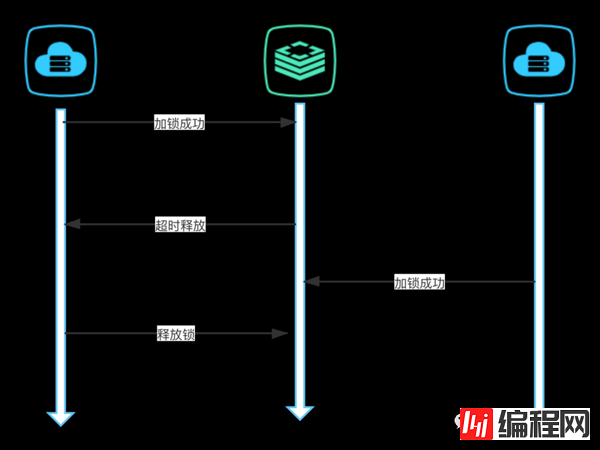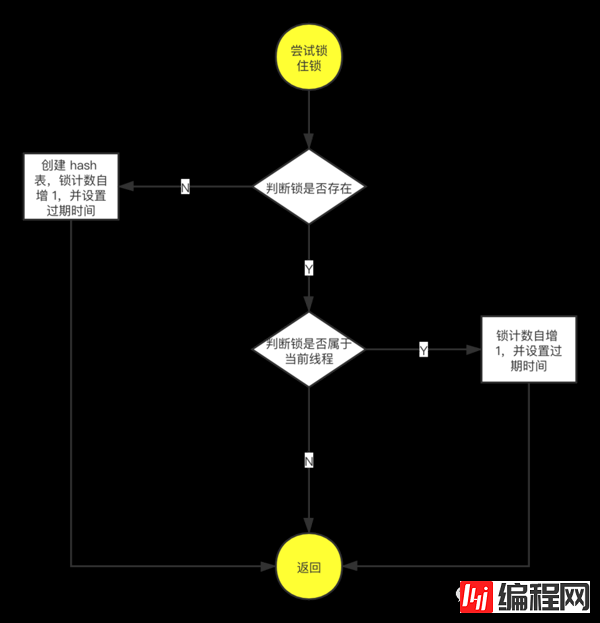这期内容当中小编将会给大家带来有关Redis中怎样实现一个分布式锁,文章内容丰富且以专业的角度为大家分析和叙述,阅读完这篇文章希望大家可以有所收获。方案使用 SETNX 和 EXPIRE 命令SETNX&n
这期内容当中小编将会给大家带来有关Redis中怎样实现一个分布式锁,文章内容丰富且以专业的角度为大家分析和叙述,阅读完这篇文章希望大家可以有所收获。
使用 SETNX 和 EXPIRE 命令
SETNX key value EXPIRE key seconds DEL key if (setnx("item_1_lock", 1)) { expire("item_1_lock", 30); try { ... 逻辑 } catch { ... } finally { del("item_1_lock"); } }这种方法看起来可以解决问题,但是有一定的风险,因为 SETNX 和 EXPIRE 这波操作是非原子性的,如果 SETNX 成功之后,出现错误,导致 EXPIRE 没有执行,导致锁没有设置超时时间形成死锁。

针对这种情况,我们可以使用 lua 脚本来保持操作原子性,保证 SETNX 和 EXPIRE 两个操作要么都成功,要么都不成功。
if (redis.call('setnx', KEYS[1], ARGV[1]) < 1) then return 0; end; redis.call('expire', KEYS[1], tonumber(ARGV[2])); return 1;通过这样的方法,我们初步解决了竞争锁的原子性问题,虽然其他功能还未实现,但是应该不会造成死锁???。
Redis 2.6.12 以上可灵活使用 SET 命令
SET key value NX EX 30 DEL key if (set("item_1_lock", 1, "NX", "EX", 30)) { try { ... 逻辑 } catch { ... } finally { del("item_1_lock"); } }改进后的方法不需要借助 lua 脚本就解决了 SETNX 和 EXPIRE 的原子性问题。现在我们再仔细琢磨琢磨,如果 A 拿到了锁顺利进入代码块执行逻辑,但是由于各种原因导致超时自动释放锁。在这之后 B 成功拿到了锁进入代码块执行逻辑,但此时如果 A 执行逻辑完毕再来释放锁,就会把 B 刚获得的锁释放了。就好比用自己家的钥匙开了别家的门,这是不可接受的。

为了解决这个问题我们可以尝试在 SET 的时候设置一个锁标识,然后在 DEL 的时候验证当前锁是否为自己的锁。
String value = UUID.randomUUID().toString().replaceAll("-", ""); if (set("item_1_lock", value, "NX", "EX", 30)) { try { ... 逻辑 } catch { ... } finally { ... lua 脚本保证原子性 } } if (redis.call('get', KEYS[1]) == ARGV[1]) then return redis.call('del', KEYS[1]) else return 0 end到这里,我们终于解决了竞争锁的原子性问题和误删锁问题。但是锁一般还需要支持可重入、循环等待和超时自动续约等功能点。下面我们学习使用一个非常好用的包来解决这些问题。
Redission 的锁,实现了可重入和超时自动续约功能,它都帮我们封装好了,我们只要按照自己的需求调用它的 api 就可以轻松实现上面所提到的几个功能点。详细功能可以查看 Redisson 文档
在项目中安装 Redisson
<dependency> <groupId>org.redisson</groupId> <artifactId>redisson</artifactId> <version>3.13.2</version> </dependency>implementation 'org.redisson:redisson:3.13.2'用 Maven 或者 Gradle 构建,目前最新版本为 3.13.2,也可以在这里 Redisson 找到你需要的版本。
简单尝试
RedissonClient redissonClient = Redisson.create(); RLock lock = redissonClient.getLock("lock"); boolean res = lock.lock(); if (res) { try { ... 逻辑 } finally { lock.unlock(); } }Redisson 将底层逻辑全部做了一个封装 ?,我们无需关心具体实现,几行代码就能使用一把完美的锁。下面我们简单折腾折腾源码 ???。
加锁
private void lock(long leaseTime, TimeUnit unit, boolean interruptibly) throws InterruptedException { long threadId = Thread.currentThread().getId(); Long ttl = tryAcquire(leaseTime, unit, threadId); if (ttl == null) { return; } RFuture<RedissonLockEntry> future = subscribe(threadId); if (interruptibly) { commandExecutor.syncSubscriptionInterrupted(future); } else { commandExecutor.syncSubscription(future); } try { while (true) { ttl = tryAcquire(leaseTime, unit, threadId); if (ttl == null) { break; } if (ttl >= 0) { try { future.getNow().getLatch().tryAcquire(ttl, TimeUnit.MILLISECONDS); } catch (InterruptedException e) { if (interruptibly) { throw e; } future.getNow().getLatch().tryAcquire(ttl, TimeUnit.MILLISECONDS); } } else { if (interruptibly) { future.getNow().getLatch().acquire(); } else { future.getNow().getLatch().acquireUninterruptibly(); } } } } finally { unsubscribe(future, threadId); } }
获取锁
private <T> RFuture<Long> tryAcquireAsync(long leaseTime, TimeUnit unit, long threadId) { if (leaseTime != -1) { return tryLockInnerAsync(leaseTime, unit, threadId, RedisCommands.EVAL_LONG); } RFuture<Long> ttlRemainingFuture = tryLockInnerAsync(commandExecutor.getConnectionManager().getCfg().getLockWatchdogTimeout(), TimeUnit.MILLISECONDS, threadId, RedisCommands.EVAL_LONG); ttlRemainingFuture.onComplete((ttlRemaining, e) -> { if (e != null) { return; } if (ttlRemaining == null) { scheduleExpirationRenewal(threadId); } }); return ttlRemainingFuture; } <T> RFuture<T> tryLockInnerAsync(long leaseTime, TimeUnit unit, long threadId, RedisStrictCommand<T> command) { internalLockLeaseTime = unit.toMillis(leaseTime); return evalWriteAsync(getName(), LonGCodec.INSTANCE, command, "if (redis.call('exists', KEYS[1]) == 0) then " + "redis.call('hincrby', KEYS[1], ARGV[2], 1); " + "redis.call('pexpire', KEYS[1], ARGV[1]); " + "return nil; " + "end; " + "if (redis.call('hexists', KEYS[1], ARGV[2]) == 1) then " + "redis.call('hincrby', KEYS[1], ARGV[2], 1); " + "redis.call('pexpire', KEYS[1], ARGV[1]); " + "return nil; " + "end; " + "return redis.call('pttl', KEYS[1]);", Collections.singletonList(getName()), internalLockLeaseTime, getLockName(threadId)); }
删除锁
public RFuture<Void> unlockAsync(long threadId) { RPromise<Void> result = new RedissonPromise<Void>(); RFuture<Boolean> future = unlockInnerAsync(threadId); future.onComplete((opStatus, e) -> { cancelExpirationRenewal(threadId); if (e != null) { result.tryFailure(e); return; } if (opStatus == null) { IllegalMonitorStateException cause = new IllegalMonitorStateException("attempt to unlock lock, not locked by current thread by node id: " + id + " thread-id: " + threadId); result.tryFailure(cause); return; } result.trySuccess(null); }); return result; } protected RFuture<Boolean> unlockInnerAsync(long threadId) { return evalWriteAsync(getName(), LongCodec.INSTANCE, RedisCommands.EVAL_BOOLEAN, "if (redis.call('hexists', KEYS[1], ARGV[3]) == 0) then " + "return nil;" + "end; " + "local counter = redis.call('hincrby', KEYS[1], ARGV[3], -1); " + "if (counter > 0) then " + "redis.call('pexpire', KEYS[1], ARGV[2]); " + "return 0; " + "else " + "redis.call('del', KEYS[1]); " + "redis.call('publish', KEYS[2], ARGV[1]); " + "return 1; " + "end; " + "return nil;", Arrays.asList(getName(), getChannelName()), LockPubSub.UNLOCK_MESSAGE, internalLockLeaseTime, getLockName(threadId)); }上述就是小编为大家分享的Redis中怎样实现一个分布式锁了,如果刚好有类似的疑惑,不妨参照上述分析进行理解。如果想知道更多相关知识,欢迎关注编程网数据库频道。
--结束END--
本文标题: Redis中怎样实现一个分布式锁
本文链接: https://lsjlt.com/news/57836.html(转载时请注明来源链接)
有问题或投稿请发送至: 邮箱/279061341@qq.com QQ/279061341
2024-10-23
2024-10-22
2024-10-22
2024-10-22
2024-10-22
2024-10-22
2024-10-22
2024-10-22
2024-10-22
2024-10-22
回答
回答
回答
回答
回答
回答
回答
回答
回答
回答
0